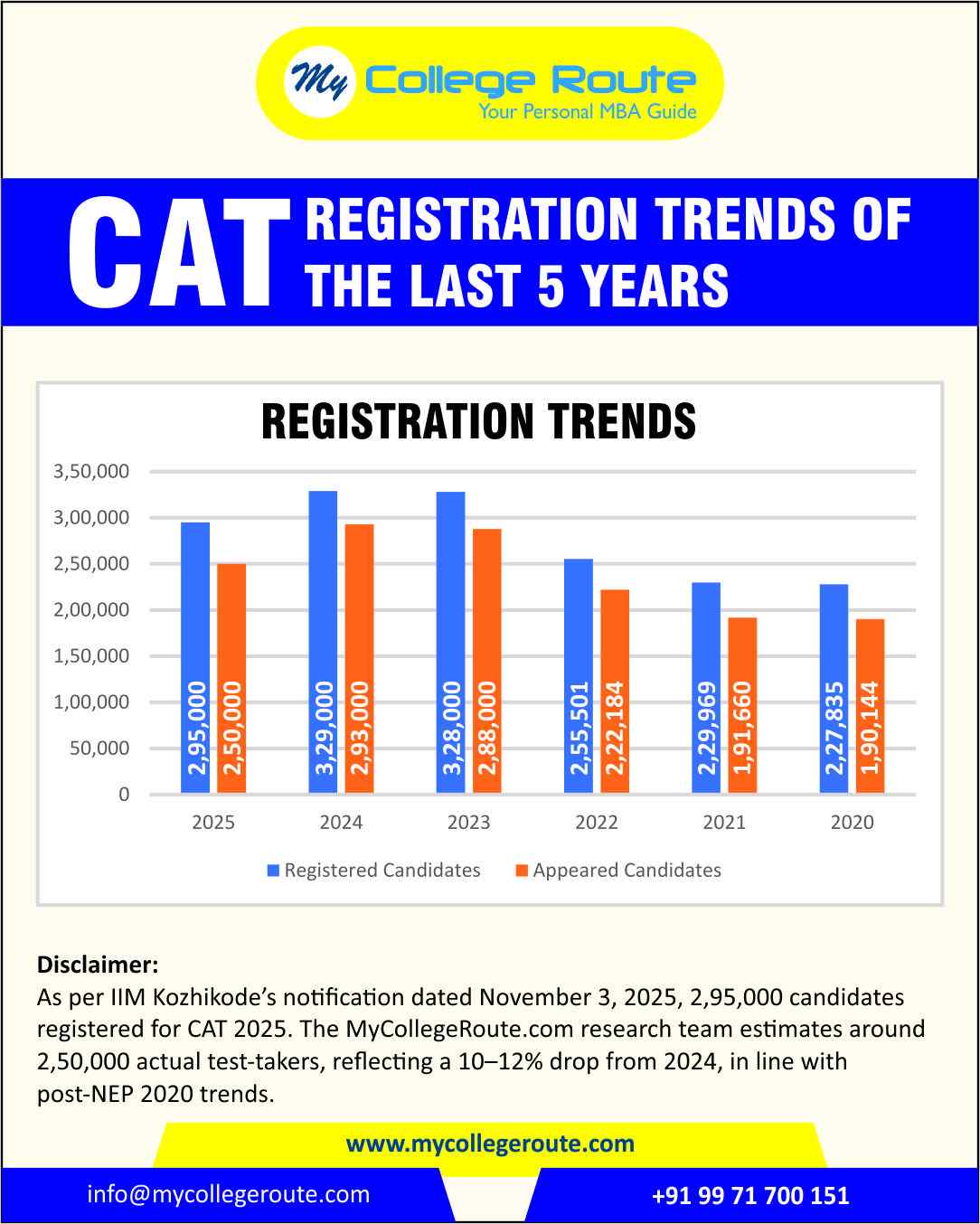CAT Exam Registration Trends for the Last 5 Years (2020–2025): Insights, Analysis & Future Outlook

The Common Admission Test (CAT) is the most competitive management entrance exam in India, serving as the primary gateway to the Indian Institutes of Management (IIMs) and over 1,200 other top B-Schools. Conducted annually by one of the IIMs on a rotational basis, CAT continues to attract aspirants from diverse academic and professional backgrounds.
Over the years, the CAT registration volume has reflected not only the growing aspirations of Indian graduates but also the macroeconomic and policy shifts impacting higher education. From pandemic-induced dips to post-NEP 2020 realignments, the past five years have told a story of both resilience and recalibration in management education demand.
Let’s explore the detailed year-wise CAT registration trends from 2020 to 2025, backed by verified data and expert insights from MyCollegeRoute’s research team.
Year-wise CAT Registration and Appearance Trends (2020–2025)
Based on official IIM notifications and verified MyCollegeRoute research estimates:
| Year | Candidates | Key Observations |
| 2025 | 295000 | Decline of 12% from 2024; post-NEP rationalization |
| 2024 | 329000 | Highest in 5 years; strong post-COVID rebound |
| 2023 | 328000 | Tech & startup job shifts driving demand |
| 2022 | 255501 | Moderate recovery from pandemic lows |
| 2021 | 229969 | COVID impact; lowest turnout of the decade |
(Source: IIMs’ official notifications and MyCollegeRoute.com analysis)
CAT 2025: A Year of Realignment
According to the official IIM Kozhikode notification dated November 3, 2025, a total of 2,95,000 candidates registered for CAT 2025. The MyCollegeRoute Research Division estimates that approximately 2.5 lakh aspirants will actually appear for the test — a 10–12% decline compared to the previous year’s 2.93 lakh test-takers.
This dip, while noticeable, aligns with broader higher-education reforms under the National Education Policy (NEP) 2020, which encourage interdisciplinary learning and multiple academic pathways beyond traditional MBA routes.
“The shift in aspirant behavior is less about decline in interest and more about diversification of career choices — with management aspirants now exploring analytics, AI, entrepreneurship, and sustainability studies.”
— Prof. Route, Academic Mentor, MyCollegeRoute.com
CAT 2024: A Record-Breaking Year
The CAT 2024 registration data marked a historic high of 3.29 lakh candidates, showcasing renewed enthusiasm after the pandemic slump. With 2.93 lakh test-takers, the participation rate touched 89%, among the highest in CAT’s history.
This spike was attributed to:
- Economic recovery and increased campus hiring across consulting and tech firms.
- Hybrid learning options, allowing working professionals to balance job and exam prep.
- Broader acceptance of CAT scores by Tier-1 private B-Schools (e.g., SPJIMR, MICA, XIME).
The year set a new benchmark for aspirant volume and reestablished CAT’s position as the most trusted exam for management education in India.
CAT 2023: Stability and Strategic Career Shifts
In 2023, 3.28 lakh aspirants registered, with 2.88 lakh appearing — almost identical to 2024 figures. However, MyCollegeRoute analysis revealed qualitative changes in the aspirant profile:
- Increased participation of STEM and analytics professionals, reflecting a demand for business-tech fusion roles.
- Rise in female registration share (≈36%), driven by targeted inclusivity initiatives by IIMs.
- Shift toward specialized one-year MBA programs, such as IIM Ahmedabad’s PGPX and IIM Calcutta’s PGPEX.
2023 was a year of consolidation — solidifying CAT’s dominance while opening new academic directions.
CAT 2022: The Recovery Year
After the pandemic disruptions of 2020–21, CAT 2022 saw the return of classroom coaching and normalcy in academic schedules. The registration count jumped from 2.27 lakh (2020) to 2.55 lakh, and appearances rose to 2.22 lakh.
Key takeaways from this transition year included:
- A surge in interest from non-engineering graduates (commerce, arts, economics).
- Adoption of AI-based proctoring and slot flexibility, enhancing exam fairness.
- A clear recovery path for B-School demand, as MBA placements hit post-COVID highs.
CAT 2021: The Pandemic Effect
The CAT 2021 cycle was unprecedented. With lockdowns and restricted travel, registrations dropped to 2.29 lakh, and only 1.91 lakh candidates appeared.
Yet, even amid global uncertainty, CAT remained resilient — maintaining over 80% appearance ratio. IIMs swiftly adapted through online proctoring systems, shorter exam durations, and section-wise restructuring, ensuring exam credibility and candidate safety.
Five-Year Trend Analysis: What the Numbers Reveal
The five-year data highlights distinct phases of growth and correction:
Phase 1 (2020–2022): Pandemic Decline & Gradual Recovery
A visible dip due to COVID-19 lockdowns, shifting career priorities, and remote learning fatigue. The total registrations fell below 2.3 lakh, before rising again by late 2022.
Phase 2 (2023–2024): Peak Resurgence
A record-breaking revival period — driven by global hiring demand, startup growth, and rising MBA ROI perception.
Phase 3 (2025): Structural Realignment
Registrations dropped by ~10–12%, not due to disinterest, but because of diversification of learning options (ed-tech upskilling, dual degrees, and hybrid MBAs).
This showcases a maturing aspirant ecosystem — where candidates are more informed, purpose-driven, and selective in their B-School choices.
Gender & Academic Diversity Trends
Recent CAT editions have demonstrated increasing gender parity and academic diversity:
- Female registration rose from 28% (2020) to 36% (2024).
- Participation from non-engineering backgrounds has grown to nearly 40%, with strong representation from economics, commerce, and humanities graduates.
This inclusivity trend supports the IIMs’ long-term vision of building classrooms that reflect real-world diversity and multidisciplinary leadership.
Factors Influencing CAT Registration Fluctuations
1. Policy Reforms (NEP 2020):
The NEP framework encourages integrated programs and flexible academic mobility — reducing one-dimensional pursuit of management degrees.
2. Employment Market Dynamics:
Rising campus placements at IITs and NITs often divert fresh graduates toward corporate roles before considering an MBA.
3. Growth of Alternate Exams:
CAT faces healthy competition from XAT, NMAT, SNAP, and CMAT, each catering to distinct institutional clusters.
4. Digital Upskilling Boom:
Working professionals increasingly prefer specialized online certifications (Analytics, AI, FinTech), impacting full-time MBA application volumes.
5. Economic Cycles:
Global slowdown fears (2024–25) have slightly tempered MBA demand, though the long-term trajectory remains upward.
Regional Insights: Where Do Most CAT Aspirants Come From?
According to MyCollegeRoute’s internal analytics and IIM registration data:
- Top Cities: Delhi-NCR, Mumbai, Pune, Bangalore, Chennai, and Kolkata contribute over 55% of all CAT registrations.
- Emerging Regions: Tier-2 cities like Indore, Jaipur, Lucknow, and Bhubaneswar show strong participation due to expanding test centers and digital access.
- International Aspirants: Around 1–2% appear from the Middle East, Singapore, and the UK for global MBA exposure.
Expert Insights from MyCollegeRoute Research Team
“The post-pandemic years have made aspirants more ROI-oriented. They no longer chase brand names alone — they evaluate placement data, alumni networks, and specialization relevance.”
— MyCollegeRoute Placement Analytics Unit
The steady registration base of 2.8–3.2 lakh annually signifies that MBA education remains aspirational, but more career-calibrated than ever before.
CAT Registration Trends vs MBA Placements (2020–2025)
Interestingly, the registration graph mirrors India’s placement momentum across IIMs and top private institutes.
- 2020–21: Placement uncertainty → Registration dip.
- 2022–23: Market rebound → Surge in applications.
- 2025: Economic moderation → Slight correction.
This cyclical correlation highlights that CAT registrations serve as a proxy indicator of confidence in India’s management job market.
MyCollegeRoute Predictions for CAT 2026
Based on multi-year trend analysis:
- Expected Registrations: 3.05–3.15 lakh candidates.
- Expected Test-Takers: ~2.75 lakh.
- Primary Growth Drivers:
- Rising hybrid MBA models.
- IIMs expanding intake (e.g., IIM Nagpur, IIM Jammu).
- Increased female participation.
- Strong placement cycles across new IIMs.
Prof. Route’s Closing Insight
“The last five years of CAT registration data underline one truth — the demand for management education in India is no longer linear; it’s adaptive, intelligent, and resilient.
The aspirant of 2026 is not just chasing a degree — they’re chasing purpose, skill integration, and leadership impact.”
— Prof. Route, Academic Mentor, MyCollegeRoute.co
© 2025 mycollegeroute.com All Rights Reserved. Website designed by Orbit Inhouse

